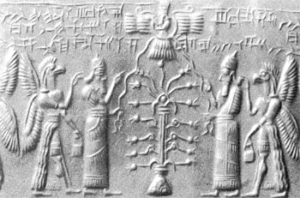Part Two
(ii):
Ashurbanipal
as Nebuchednezzar,
“Cosmic
Tree”
by
Damien F. Mackey
“The emperor
is addressed as the one who stretches out and provides shelter for his
vassals - similar to Nebuchadnezzar in Dan 4 ...”.
M. H. Henze
Certain
passages in M. H. Henze’s book, The
Madness of King Nebuchadnezzar:
The Ancient Near Eastern Origins and Early History of Interpretation of Daniel
4 (BRILL, 1999), do no harm whatsoever to
my identification, in this series (see also: https://www.academia.edu/33428527/Ashurbanipal_Manasseh_Necho_I-II_Nebuchednezzar._Part_Two_i_Ashurbanipal_as_Nebuchednezzar )
of Ashurbanipal as Nebuchednezzar.
And so we read of the emperor as
like a sheltering, cosmic tree (pp. 80-81):
....
In addition to these more general commonalties in the portraits of the sacred tree throughout the ancient world, there are a number of peculiar
details in the description of the cosmic tree in Dan 4 that
stand without parallel in
the Hebrew Bible, and which therefore demand further attention. One such detail
is the literary context of the
tree vision. As already observed, the entire story of Nebuchadnezzar's
madness is cast, at least in the
Aramaic version, in the form of an encyclical epistle sent by the king “to all peoples, nations, and tongues” (Dan 3:31). We find the same
image of the monarch as a giant
tree in the prescript of an Assyrian epistle. It is part of the
introductory blessing formulae in a letter sent to the Neo-Assyrian
king Ashurbanipal by a certain
Adad-šum-usur, a prominent diviner (barû)
and royal advisor (ummānu) already during the
time Ashurbanipal’s father Esarhaddon ....
My comment:
According to my neo-Assyrian revision, Esarhaddon was not the father of
Ashurbanipal, but was Ashurbanipal,
hence was Nebuchednezzar.
See e.g. my article:
Esarhaddon a tolerable fit for King
Nebuchednezzar
That
would mean that Adad-šum-usur above would not need to be so stretched
chronologically as to have to have embraced two reigns (Esarhaddon plus
Ashurbanipal). Now, the biblical Ahikar (Achior) was Esarhaddon’s ummānu. And W. van Soden has suggested
that Adad-šum-usur might have been the model for Ahikar (see Wisdom in Ancient Israel, p. 43, n. 3).
Returning to M.
H. Henze and Adad-šum-usur
... who exercised considerable influence in the court. .... The line
in question reads as follows,
zīmīka (MÚŠ-ka) lišmuḫu lirappišu ṣulūlī
(may the gods
grant progeny to the king, my lord) may your
countenance flourish (and) make shelter wide ....
The letter, which probably stems from the beginning of Ashurbanipal's
reign around the year 666 BCE [sic], opens with a
sequence of blessings. Line 14, the
line quoted above, concludes this
introductory section of the epistle. The emperor is addressed as the one who
stretches out and provides shelter for his vassals - similar to Nebuchadnezzar
in Dan 4 who, in the form of a
cosmic tree, has grown large in order to host all the
nations of the world (Dan 4:8–9.19). ....

No comments:
Post a Comment